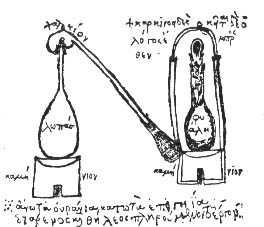Jabir ibn Hayyan
Abū Mūsā Jābir ibn Hayyān (Arabic/Persian جابر بن حيان, often given the nisbas, al-Azdi, al-Kufi, al-Tusi or al-Sufi; fl. c. 721 – c. 815),[3] is the supposed[4] author of an enormous number and variety of works in Arabic often called the Jabirian corpus.[5] The scope of the corpus is vast and diverse covering a wide range of topics, including alchemy, cosmology, numerology, astrology, medicine, magic, mysticism and philosophy.[6]
Jabir ibn Hayyan | |
|---|---|
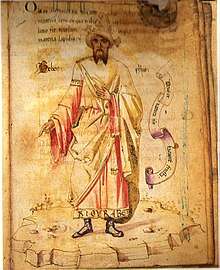 15th-century European portrait of "Geber", Codici Ashburnhamiani 1166, Biblioteca Medicea Laurenziana, Florence | |
| Title | Father of Chemistry |
| Personal | |
| Born | Abu Musa Jabir ibn Hayyan c. 721 CE Tus, Khurasan, Umayyad Caliphate[1] |
| Died | c. 815 CE (aged 94) |
| Religion | Islam |
| Era | Islamic Golden Age |
| Denomination | Shia[2] |
| Main interest(s) | Alchemy and Chemistry, Astronomy, Astrology, Medicine and Pharmacy, Philosophy, Physics, philanthropist |
| Notable work(s) | Kitab al-Kimya, Kitab al-Sab'een, Book of the Kingdom, Book of the Balances, Book of Eastern Mercury, etc. |
| Muslim leader | |
Influenced by
| |
Influenced
| |
Popularly known as the father of chemistry, Jabir's works contain the oldest known systematic classification of chemical substances, and the oldest known instructions for deriving an inorganic compound (sal ammoniac or ammonium chloride) from organic substances (such as plants, blood, and hair) by chemical means.[7]
As early as the 10th century, the identity and exact corpus of works of Jabir was in dispute in Islamic circles.[8] The authorship of all these works by a single figure, and even the existence of a historical Jabir, are also doubted by modern scholars.[4][9] Instead, Jabir ibn Hayyan is seen more like a pseudonym to whom "underground writings" by various authors became ascribed.[10]
Some Arabic Jabirian works (e.g., the "Book of Mercy", and the "Book of Seventy") were translated into Latin under the Latinized name "Geber",[11] and in 13th-century Europe an anonymous writer, usually referred to as pseudo-Geber, started to produce alchemical and metallurgical writings under this name.[12]
Biography
Early references
In 988 Ibn al-Nadim compiled the Kitab al-Fihrist which mentions Jabir as a spiritual follower, companion and as a student to Jafar as-Sadiq, the sixth Shia Imam. In another reference al-Nadim reports that a group of philosophers claimed Jabir was one of their own members. Another group, reported by al-Nadim, says only The Large Book of Mercy is genuine and that the rest are pseudographical. Their assertions are rejected by al-Nadim.[8] Joining al-Nadim in asserting a real Jabir; Ibn-Wahshiyya ("Jaber ibn Hayyn al-Sufi ...book on poison is a great work...") Rejecting a real Jabir; (the philosopher c. 970) Abu Sulayman al-Sijistani claims the real author is one al-Hasan ibn al-Nakad al-Mawili. The 14th century critic of Arabic literature, Jamal al-Din ibn Nubata al-Misri declares all the writings attributed to Jabir doubtful.[6]
Life and background
According to the philologist-historian Paul Kraus (1904–1944), Jabir cleverly mixed in his alchemical writings unambiguous references to the Ismaili or Qarmati movement. Kraus wrote: "Let us first notice that most of the names we find in this list have undeniable affinities with the doctrine of Shi'i Gnosis, especially with the Ismaili system."[13] Henry Corbin believes that Jabir ibn Hayyan was an Ismaili.[14] Jabir was a natural philosopher who lived mostly in the 8th century; he was born in Tus, Khorasan, in Persia,[3] then ruled by the Umayyad Caliphate. Jabir in the classical sources has been variously attributed as al-Azdi, al-Kufi, al-Tusi, al-Sufi, al-Tartusi or al-Tarsusi, and al-Harrani.[15][16] There is a difference of opinion as to whether he was an Arab[17] from Kufa who lived in Khurasan, or a Persian[18][19][20] from Khorasan who later went to Kufa[15] or whether he was, as some have suggested, of Syrian Sabian[21] origin and later lived in Persia and Iraq.[15] In some sources, he is reported to have been the son of Hayyan al-Azdi, a pharmacist of the Arabian Azd tribe who emigrated from Yemen to Kufa (in present-day Iraq).[22] while Henry Corbin believes Geber seems to have been a non-Arab client of the 'Azd tribe.[23] Hayyan had supported the Abbasid revolt against the Umayyads, and was sent by them to the province of Khorasan to gather support for their cause. He was eventually caught by the Umayyads and executed. His family fled to Yemen,[22][24] perhaps to some of their relatives in the Azd tribe,[25] where Jabir grew up and studied the Quran, mathematics and other subjects.[22] Jabir's father's profession may have contributed greatly to his interest in alchemy.
After the Abbasids took power, Jabir went back to Kufa. He began his career practicing medicine, under the patronage of a Vizir (from the noble Persian family Barmakids) of Caliph Harun al-Rashid. His connections to the Barmakid cost him dearly in the end. When that family fell from grace in 803, Jabir was placed under house arrest in Kufa, where he remained until his death.
It has been asserted that Jabir was a student of the sixth Imam Ja'far al-Sadiq and Harbi al-Himyari;[8][26] however, other scholars have questioned this theory.[27]
The Jabirian corpus
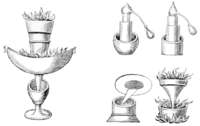
In total, nearly 3,000 treatises and articles are credited to Jabir ibn Hayyan.[28] Following the pioneering work of Paul Kraus, who demonstrated that a corpus of some several hundred works ascribed to Jābir were probably a medley from different hands,[6]:3[29] mostly dating to the late 9th and early 10th centuries, many scholars believe that many of these works consist of commentaries and additions by his followers, particularly of an Ismaili persuasion.[30] On the other hand, contemporary scholar Syed Nomanul Haq refuses the multiplicity of authors hypothesis, and says that Kraus has misrepresented the Jabirian corpus for three main reasons : a) he hasn't inspected the bibliographies correctly, considering that there have been many leaps (in one instance, we have no titles between 500 and 530), so, all in all, the numbers are more over 500 than close to 3000 ; b) in many cases, a part or chapter of a book has been counted as a book itself, like with the Kitab al-Jumal al-'Ishrin (book of twenty maxims), which has been counted for 20 books and c) finally, many of the supposed "books" are not so in the formal sense, the Kitab al-Sahl occupying a single paragraph and many others few folios. Syed Nomanul Haq concludes that "this rough investigation makes it abundantly clear that we should view with a great deal of suspicion any arguments for a plurality of authors which is based on Kraus' inflated estimate of the volume of the Jabirian corpus."[31]
The scope of the corpus is vast: cosmology, music, medicine, magic, biology, chemical technology, geometry, grammar, metaphysics, logic, artificial generation of living beings, along with astrological predictions, and symbolic Imâmî myths.[6]:5
- The 112 Books dedicated to the Barmakids, viziers of Caliph Harun al-Rashid. This group includes the Arabic version of the Emerald Tablet, an ancient work that proved a recurring foundation of and source for alchemical operations. In the Middle Ages it was translated into Latin (Tabula Smaragdina) and widely diffused among European alchemists.
- The Seventy Books, most of which were translated into Latin during the Middle Ages. This group includes the Kitab al-Zuhra ("Book of Venus") and the Kitab Al-Ahjar ("Book of Stones").
- The Ten Books on Rectification, containing descriptions of alchemists such as Pythagoras, Socrates, Plato and Aristotle.
- The Books on Balance; this group includes his most famous 'Theory of the balance in Nature'.
Jabir states in his Book of Stones (4:12) that "The purpose is to baffle and lead into error everyone except those whom God loves and provides for". His works seem to have been deliberately written in highly esoteric code (see steganography), so that only those who had been initiated into his alchemical school could understand them. It is therefore difficult at best for the modern reader to discern which aspects of Jabir's work are to be read as ambiguous symbols, and what is to be taken literally.
People
Jabir professed to have drawn his alchemical inspiration from earlier writers, both legendary and historic, on the subject.[32] In his writings, Jabir pays tribute to Egyptian and Greek alchemists Zosimos, Democritus, Hermes Trismegistus, Agathodaemon, but also Plato, Aristotle, Galen, Pythagoras, and Socrates, as well as the commentators Alexander of Aphrodisias, Simplicius, Porphyry and others.[6]:5
A huge pseudo-epigraphic literature of alchemical books was composed in Arabic, among which the names of Persian authors also appear like Jāmāsb, Ostanes, Mani, testifying that alchemy-like operations on metals and other substances were also practiced in Persia. The great number of Persian technical names (zaybaq = mercury, nošāder = sal-ammoniac) also corroborates the idea of an important Iranian root of medieval alchemy.[33] Ibn al-Nadim reports a dialogue between Aristotle and Ostanes, the Persian alchemist of Achaemenid era, which is in Jabirian corpus under the title of Kitab Musahhaha Aristutalis.[34] Ruska had suggested that the Sasanian medical schools played an important role in the spread of interest in alchemy.[33] He emphasizes the long history of alchemy, "whose origin is Arius ... the first man who applied the first experiment on the [philosopher's] stone... and he declares that man possesses the ability to imitate the workings of Nature" (Nasr, Seyyed Hussein, Science and Civilization of Islam).
Theories
Jabir's alchemical investigations ostensibly revolved around the ultimate goal of takwin, the artificial creation of life. The Book of Assemblage "Kitāb Al-Tajmi' "[35] includes several recipes for creating creatures such as scorpions, snakes, and even humans in a laboratory environment, which are subject to the control of their creator. What Jabir meant by these recipes is unknown.
Jabir's alchemical investigations were theoretically grounded in an elaborate numerology related to Pythagorean and Neoplatonic systems. The nature and properties of elements were defined through numeric values assigned to the Arabic consonants present in their name.
By Jabir's time Aristotelian physics had become Neoplatonic. Each Aristotelian element was composed of these qualities: fire was both hot and dry, earth, cold and dry, water cold and moist, and air, hot and moist. This came from the elementary qualities which are theoretical in nature plus substance. In metals two of these qualities were interior and two were exterior. For example, lead was cold and dry and gold was hot and moist. Thus, Jabir theorized, by rearranging the qualities of one metal, a different metal would result. Like Zosimos, Jabir believed this would require a catalyst, an al-iksir, the elusive elixir that would make this transformation possible – which in European alchemy became known as the philosopher's stone.[6]
According to Jabir's mercury-sulfur theory, metals differ from each in so far as they contain different proportions of the sulfur and mercury. These are not the elements that we know by those names, but certain principles to which those elements are the closest approximation in nature.[36] Based on Aristotle's "exhalation" theory the dry and moist exhalations become sulfur and mercury (sometimes called "sophic" or "philosophic" mercury and sulfur). The sulfur-mercury theory is first recorded in a 7th-century work Secret of Creation credited (falsely) to Balinus (Apollonius of Tyana). This view becomes widespread.[37] In the Book of Explanation Jabir says
the metals are all, in essence, composed of mercury combined and coagulated with sulphur [that has risen to it in earthy, smoke-like vapors]. They differ from one another only because of the difference of their accidental qualities, and this difference is due to the difference of their sulphur, which again is caused by a variation in the soils and in their positions with respect to the heat of the sun
Holmyard says that Jabir proves by experiment that these are not ordinary sulfur and mercury.[22]
The seeds of the modern classification of elements into metals and non-metals could be seen in his chemical nomenclature. He proposed three categories:[38]
- "Spirits" which vaporise on heating, like arsenic (realgar, orpiment), camphor, mercury, sulfur, sal ammoniac, and ammonium chloride.
- "Metals", like gold, silver, lead, tin, copper, iron, and khar-sini (Chinese iron)
- Non-malleable substances, that can be converted into powders, such as stones.
The origins of the idea of chemical equivalents might be traced back to Jabir, in whose time it was recognized that "a certain quantity of acid is necessary in order to neutralize a given amount of base."[39]
Laboratory equipment and material
The Jabirian corpus is renowned for its contributions to alchemy. It shows a clear recognition of the importance of experimentation, "The first essential in chemistry is that thou shouldest perform practical work and conduct experiments, for he who performs not practical work nor makes experiments will never attain to the least degree of mastery."[40] He is credited with the use of over twenty types of now-basic chemical laboratory equipment,[41] such as the alembic[42] and retort, and with the description of many now-commonplace chemical processes – such as crystallisation, various forms of alchemical "distillation", and substances citric acid (the sour component of lemons and other unripe fruits), acetic acid (from vinegar) and tartaric acid (from wine-making residues), arsenic, antimony and bismuth, sulfur, and mercury[40][41] that have become the foundation of today's chemistry.[43]
According to Ismail al-Faruqi and Lois Lamya al-Faruqi, "In response to Jafar al-Sadiq's wishes, [Jabir ibn Hayyan] invented a kind of paper that resisted fire, and an ink that could be read at night. He invented an additive which, when applied to an iron surface, inhibited rust and when applied to a textile, would make it water repellent."[44]
Mineral acids and alcohol
Directions to make mineral acids such as sulfuric acid, nitric acid and aqua regis appear in the Arabic Jabirian corpus,[45] and later in the pseudo-Geberian works Liber Fornacum, De inventione perfectionis, and the Summa.[46]
According to Forbes, there is no proof that Jabir knew alcohol.[46] Later, Al-Kindi unambiguously described the distillation of wine in the 9th century.[47][48][49]
Legacy
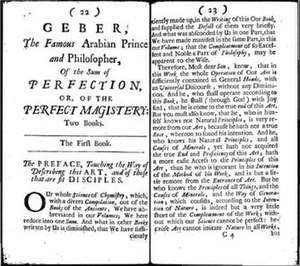
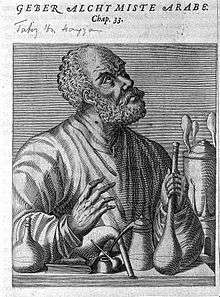
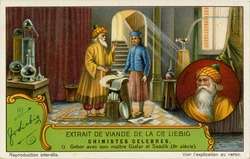
Whether Jabir lived in the 8th century or not, his name would become the most famous in alchemy.[27] He paved the way for most of the later alchemists, including al-Kindi, al-Razi, al-Tughrai and al-Iraqi, who lived in the 9th–13th centuries. His books strongly influenced the medieval European alchemists[43] and justified their search for the philosopher's stone.[50][51] In the Middle Ages, Jabir's treatises on alchemy were translated into Latin and became standard texts for European alchemists. These include the Kitab al-Kimya (titled Book of the Composition of Alchemy in Europe), translated by Robert of Chester (1144); and the Kitab al-Sab'een (Book of Seventy) by Gerard of Cremona (before 1187). Marcelin Berthelot translated some of his books under the fanciful titles Book of the Kingdom, Book of the Balances, and Book of Eastern Mercury. Several technical Arabic terms introduced by Jabir, such as alkali, have found their way into various European languages and have become part of scientific vocabulary.
Max Meyerhoff states of Jabir ibn Hayyan:
"His influence may be traced throughout the whole historic course of European alchemy and chemistry."[43]
The historian of chemistry Erick John Holmyard gives credit to Jabir for developing alchemy into an experimental science and he writes that Jabir's importance to the history of chemistry is equal to that of Robert Boyle and Antoine Lavoisier. The historian Paul Kraus, who had studied most of Jabir's extant works in Arabic and Latin, summarized the importance of Jabir to the history of chemistry by comparing his experimental and systematic works in chemistry with that of the allegorical and unintelligible works of the ancient Greek alchemists.[52] The word gibberish is theorized to be derived from the Latinised version of Jabir's name,[53] in reference to the incomprehensible technical jargon often used by alchemists, the most famous of whom was Jabir.[54][55] The Oxford English Dictionary suggests the term stems from gibber; however, the first known use of the term "gibberish" dates prior to the first known use of the word "gibber".
The Geber-Jabir problem
The identity of the author of works attributed to Jabir has long been discussed.[8] According to a famous controversy,[56] pseudo-Geber has been considered as the unknown author of several books in Alchemy.[57] This was first independently suggested, on textual and other grounds, by the 19th-century historians Hermann Kopp and Marcellin Berthelot.[58] Jabir, by reputation the greatest chemist of Islam, has long been familiar to western readers under the name of Geber, which is the medieval rendering of the Arabic Jabir, the Geber of the Middle Ages.[59] The works in Latin corpus were considered to be translations until the studies of Kopp, Hoefer, Berthelot, and Lippman. Although they reflect earlier Arabic alchemy they are not direct translations of "Jabir" but are the work of a 13th-century Latin alchemist.[60] Eric Holmyard says in his book Makers of Chemistry Clarendon press.(1931).[61]
There are, however, certain other Latin works, entitled The Sum of Perfection, The Investigation of Perfection, The Invention of Verity, The Book of Furnaces, and The Testament, which pass under his name but of which no Arabic original is known. A problem which historians of chemistry have not yet succeeded in solving is whether these works are genuine or not.
However, by 1957 when he (Holmyard) wrote Alchemy[62] Holmyard had abandoned the idea of an Arabic original (although they are based on "Islamic" alchemical theories).
The question at once arises whether the Latin works are genuine translations from the Arabic, or written by a Latin author and, according to common practice, ascribed to Jabir in order to heighten their authority. That they are based on Muslim alchemical theory and practice is not questioned, but the same may be said of most Latin treatises on alchemy of that period; and from various turns of phrase it seems likely that their author could read Arabic. But the general style of the works is too clear and systematic to find a close parallel in any of the known writings of the Jabirian corpus, and we look in vain in them for any references to the characteristically Jabirian ideas of "balance" and the alphabetic numerology. Indeed for their age they have a remarkably matter of fact air about them, theory being stated with a minimum of prolixity and much precise practical detail being given. The general impression they convey is that they are the product of an occidental rather than an oriental mind, and a likely guess would be that they were written by a European scholar, possibly in Moorish Spain. Whatever their origin, they became the principal authorities in early Western alchemy and held that position for two or three centuries.
The question of Pseudo-Gebers identity was still in dispute in 1962.[63] It is said that Geber, the Latinized form of "Jabir," was adopted presumably because of the great reputation of a supposed 8th-century alchemist by the name of Jabir ibn Hayyan.[64] About this historical figure, however, there was considerable uncertainty a century ago,[65] and the uncertainty continues today.[66] This is sometimes called the "Geber-Jābir problem".[8] It is possible that facts mentioned in the Latin works, ascribed to Geber and dating from the twelfth century and later, may be placed to Jabir's credit.[59]
In 2005, the historian Ahmad Y. Al-Hassan pointed out that earlier Arabic texts prior to the 13th century, including the works of Jabir and Al-Razi, already contained detailed descriptions of substances such as nitric acid, aqua regia, vitriol, and various nitrates.[45] In 2009, Al-Hassan criticized Berthelot's original hypothesis and, on textual grounds, argued that the Pseudo-Geber Corpus was originally written in Arabic. Al-Hassan criticized Berthelot's lack of familiarity with the complete Arabic corpus and pointed to various Arabic Jabirian manuscripts which already contain much of the theories and practices that Berthelot previously attributed to the Latin corpus.[67] Regardless of the identity of pseudo-Geber, the contents of the Pseudo-Geber Corpus are mostly derived from earlier Arabic alchemy, including the work of Jabir as well as other Arabic authors such as Al-Razi.[67]
In popular culture
- Geber is mentioned in Paulo Coelho's 1993 bestseller, The Alchemist.[68]
- Geber is mentioned in H. P. Lovecraft's novel The Case of Charles Dexter Ward.
- Jabbir is said to be the creator of a (fictional) mystical chess set in Katherine Neville's novels The Eight and The Fire.
- In S.H.I.E.L.D, Jabir appears as the 8th century leader of the organization.[69]
- Jabir is mentioned in the American sitcom The Big Bang Theory, in the episode "The Guitarist Amplification".
- Jabir Ibn Hayyan is mentioned in the graphic novel Habibi by Craig Thompson, pp. 253–254.
- In the DC comic book title Demon Knights, the 11th century engineer Al-Jabr appears to be based on Jabir Ibn Hayyan.
- Jabir Ibn Hayyan is mentioned in Satyajit Ray's short stories of Professor Shonku.
Bibliography
The Pseudo-Geber corpus
The Latin corpus consists of books with an author named "Geber" for which researchers have failed to find a text in Arabic. These books were heavily influenced by Arabic books written by Jabir, the "real" Geber, and by Al Razi and others. They are available in Latin only, date from about the year 1310, and their author is identified as "Geber" or pseudo-Geber:
- Summa perfectionis magisterii ("The Height of the Perfection of Mastery").[70]
- Liber fornacum ("Book of Furnaces"),
- De investigatione perfectionis ("On the Investigation of Perfection"), and
- De inventione veritatis ("On the Discovery of Truth").
- Testamentum gerberi
The Liber fornacum, De investigatione perfectionis and De inventione veritatis "are merely extracts from or summaries of the Summa Perfectionis Magisterii with later additions."[71] which may have been compiled by later writers.
English translations of Jabir and the Pseudo-Geber
- Syed Nomanul Haq, Names, Natures and Things: The Alchemists Jabir ibn Hayyan and his Kitab al-Ahjar (Book of Stones), [Boston Studies in the Philosophy of Science p. 158] (Dordrecht: Kluwer Academic Publishers, 1994), ISBN 0-7923-3254-7.
- Donald Routledge Hill, 'The Literature of Arabic Alchemy' in Religion: Learning and Science in the Abbasid Period, ed. by M.J.L. Young, J.D. Latham and R.B. Serjeant (Cambridge University Press, 1990) pp. 328–341 [333–335].
- E. J. Holmyard (ed.) The Arabic Works of Jabir ibn Hayyan, translated by Richard Russel in 1678. New York, E.P. Dutton (1928); Also Paris, P. Geuther.
- Geber and William R. Newman, The Summa Perfectionis of Pseudo-Geber: A Critical Edition, Translation and Study ISBN 978-90-04-09464-2.
- William R. Newman, New Light on the Identity of Geber, Sudhoffs Archiv, 1985, Vol.69, pp. 76–90.
See also
References
- Tus, V. Minorsky, The Encyclopaedia of Islam, Vol. X, ed. P.J. Bearman, T. Bianquis, C.E. Bosworth, E. van Donzel and W.P. Heinrichs, (Brill, 2000), 741.
- "KIMIĀ – Encyclopaedia Iranica". www.iranicaonline.org. Retrieved 29 August 2019.
The treatises were probably composed in Iraq by a school of Shiʿite alchemists during the 9th and 10th centuries (Kraus, 1943, Introduction).
- "Abu Musa Jabir ibn Hayyan". Encyclopædia Britannica Online. Retrieved 11 February 2008.
- Forster, Regula (1 December 2018). "Jābir b. Ḥayyān". Encyclopaedia of Islam, THREE.
- "Jabir | Encyclopedia.com". www.encyclopedia.com.
- Haq, Syed Nomanul (28 February 1995). Names, Natures and Things: The Alchemist Jabir Ibn Hayyan and His Kitab Al-Ahjar (Book of Stones). Springer. ISBN 978-0-7923-3254-1.
- Stapleton, H.E; Azo, R.F & Hidayat Husain, M. "Chemistry in Iraq and Persia in the Tenth Century A.D"., Memoirs of the Asiatic Society of Bengal, vol. VIII, no. 6, 1927, pp. 317-418 (here pp. 338-340).
- Brabner, Tod (2005). "Jabir ibn Hayyam (Geber)". In Thomas F. Glick; Steven John Livesey; Faith Wallis (eds.). Medieval Science, Technology, and Medicine: An Encyclopedia. Psychology Press. pp. 279–281. ISBN 978-0-415-96930-7.
- Delva, Thijs (15 June 2017). "The Abbasid Activist Ḥayyān al-ʿAṭṭār as the Father of Jābir b. Ḥayyān: An Influential Hypothesis Revisited". Journal of Abbasid Studies. 4: 35–61. doi:10.1163/22142371-12340030.
- Encyclopedia Britannica, "Alchemy: Arab alchemy"
- Darmstaedter, Ernst. "Liber Misericordiae Geber: Eine lateinische Übersetzung des gröβeren Kitâb l-raḥma", Archiv für Geschichte der Medizin, 17/4, 1925, pp. 181–197; Berthelot, Marcellin. "Archéologie et Histoire des sciences", Mémoires de l’Académie des sciences de l’Institut de France, 49, 1906, pp. 308–363; see also Forster, Regula. "Jābir b. Ḥayyān", Encyclopaedia of Islam, Three.
- Newman, William R. "New Light on the Identity of Geber", Sudhoffs Archiv, 1985, 69, pp. 76–90; Newman, William R. The Summa perfectionis of Pseudo-Geber: A critical edition, translation and study, Leiden: Brill, 1991, pp. 57–103. It has been argued by Ahmad Y. Al-Hassan that the pseudo-Geber works were actually translated into Latin from the Arabic (see Al-Hassan, Ahmad Y. "The Arabic Origin of the Summa and Geber Latin Works: A Refutation of Berthelot, Ruska, and Newman Based on Arabic Sources", in: Ahmad Y. Al-Hassan. Studies in al-Kimya': Critical Issues in Latin and Arabic Alchemy and Chemistry. Hildesheim: Georg Olms Verlag, 2009, pp. 53–104; also available online).
- Paul Kraus "Dignitaires de la hierarchie religieuse selon Gabir ibn Hayyan', Bulletin de l'Institut Francais d'Archeologie Orientale de Caire (1942): 85.
- Diana, Steigerwald (2015). Imamology in Ismaili Gnosis. New Delhi: Manohar Publishers & Distributors. p. 141. ISBN 978-93-5098-081-1.
- S.N. Nasr, "Life Sciences, Alchemy and Medicine", The Cambridge History of Iran, Cambridge, Volume 4, 1975, p. 412: "Jabir is entitled in the traditional sources as al-Azdi, al-Kufi, al-Tusi, al-Sufi. There is a debate as to whether he was an Arab from Kufa who lived in Khurasan, or a Persian from Khorasan who later went to Kufa or whether he was, as some have suggested, of Syrian origin and later lived in Persia and Iraq".
- Selin, Helaine (2008). Encyclopaedia of the History of Science, Technology, and Medicine in Non-Western Cultures. Springer Science & Business Media. p. 101."Elsewhere his name is given as Abu Musa, and he is variously described as Tusi, Tartusi or Tarsusi, Harranian and from Khorasan (Holmyard 1923: 47)."
- Holmyard, Eric John, Introduction to The Works of Geber, translated by Richard Russell. (London: Dent, 1928), p. vii: "Abu Musa Jabir ibn Hayyan, generally known merely as Jabir, was the son of a druggist belonging to the famous South Arabian tribe of Al-Azd. Members of this tribe had settled at the town of Kufa, in Iraq, shortly after the Muhammadan conquest in the seventh century A.D., and it was in Kufa that Hayyan the druggist lived."
- Ragep, F. Jamil; Ragep, Sally P.; Livesey, Steven John (1996). Tradition, Transmission, Transformation: Proceedings of Two Conferences on Pre-Modern Science Held at the University of Oklahoma. BRILL. p. 178. ISBN 978-90-04-10119-7.
This language of extracting the hidden nature formed an important lemma for the extensive corpus associated with the Persian alchemist Jabir ibn Hayyan as well.
- George Sarton, Introduction to the History of Science, Pub. for the Carnegie Institution of Washington, by the Williams & Wilkins Company, 1931, vol. 2 pt. 1, p. 1044: "Was Geber, as the name would imply, the Persian alchemist Jabir ibn Haiyan?"
- William R. Newman, Gehennical Fire: The Lives of George Starkey, an American Alchemist in the Scientific Revolution, Harvard University Press, 1994. p. 94: "According to traditional bio-bibliography of Muslims, Jabir ibn Hayyan was a Persian alchemist who lived at some time in the eighth century and wrote a wealth of books on virtually every aspect of natural philosophy."
- Cyril Glassé; Huston Smith, The New Encyclopedia of Islam, (2003), Rowman Altamira, p. 233: "Jabir ibn Hayyan. A celebrated alchemist, not a Muslim, but a Harranian from the community of the Harranian "Sabians" of North Syria."
- Holmyard, Eric John (1931). Makers of Chemistry. The Clarendon press.
- Henry Corbin, "The Voyage and the Messenger: Iran and Philosophy", Translated by Joseph H. Rowe, North Atlantic Books, 1998. p. 45: "The Nisba al-Azdin certainly does not necessarily indicate Arab origin. Geber seems to have been a client of the Azd tribe established in Kufa."
- E.J. Holmyard (ed.) The Arabic Works of Jabir ibn Hayyan, translated by Richard Russell in 1678. New York, E.P. Dutton (1928); Also Paris, P. Geuther.
- Holmyard, E.J. (2012). Alchemy. Courier Corporation. ISBN 978-0-486-15114-4.
- Haq, Syed N. (1994). Names, Natures and Things. Dordrecht, The Netherlands: Boston Studies in the Philosophy of Science, Volume 158/ Kluwar Academic Publishers. pp. 14–20. ISBN 978-0-7923-3254-1.
- "Iranica JAʿFAR AL-ṢĀDEQ iv. And Esoteric sciences". Retrieved 11 June 2011.
The historical relations between Jaʿfar al-Ṣādeq and Jāber b. Ḥayyān remain very controversial, as they are linked to still unresolved questions about dating, composition, and authorship of the texts attributed to Jāber. Scholars such as Julius Ruska, Paul Kraus, and Pierre Lory consider Jaʿfar al-Ṣādeq’s involvement in the transmission of alchemical knowledge as a literary fiction, whereas Fuat Sezgin, Toufic Fahd, and Nomanul Haq are rather inclined to accept the existence of alchemical activity in Medina in Jaʿfar al-Ṣādeq’s time, although they remain cautious regarding the authenticity of the attribution of the Jaberian corpus to Jāber b. Ḥayyān and of the alchemical works to Jaʿfar al-Ṣādeq (Ruska, 1924, pp. 40–52; idem, 1927, pp. 264–266; Kraus, I, pp. lv-lvii; Lory, pp. 14–21, 57–59, 101–107; Sezgin, I, p. 529, IV, pp. 128–311; Fahd, 1970, pp. 139–141; Nomanul Haq, pp. 3–47).
- Josef W. Meri; Jere L. Bacharach (2006). Medieval Islamic Civilization. Taylor and Francis. p. 25. ISBN 978-0-415-96691-7.
- Jabir Ibn Hayyan. Vol. 1. Le corpus des ecrits jabiriens. George Olms Verlag, 1989
- Paul Kraus, Jabir ibn Hayyan: Contribution à l'histoire des idées scientifiques dans l'Islam, cited Robert Irwin, 'The long siesta' in Times Literary Supplement, 25 January 2008 p.8
- Syed Nomanul Haq, Names, Natures and Things: The Alchemist Jābir ibn Hayyān and his Kitāb al-Ahjār (Book of Stones), Springer Science & Business Media (2012), pp. 11–12
- Julian, Franklyn, Dictionary of the Occult, Kessinger Publishing, 2003, ISBN 0-7661-2816-4, 978-0-7661-2816-3, p. 9.
- KIMIĀ ("Alchemy"), Encyclopedia Iranica, Retrieved on 19 November 2017.
- "History of Islamic Science" (PDF). University of Southern California. Archived from the original (PDF) on 7 October 2013.
- Jābir Ben Hayyān; Al-Mizyadi, Ahmad (2006). Rasāil Jābir Ben Hayyān (Letters of Jābir Ben Hayyān). Lebanon: Dar Al-Kotob Al-Ilmiyah. p. 229. ISBN 978-2-7451-5398-2.
- Holmyard, E.J. (1931). Makers of Chemistry. Oxford: Clarendon Press. pp. 57–58.
- Norris, John (March 2006). "The Mineral Exhalation Theory of Metallogenesis in Pre-Modern Mineral Science". Ambix. 53: 43–65. doi:10.1179/174582306X93183.
- Georges C. Anawati, "Arabic alchemy", in R. Rashed (1996), The Encyclopaedia of the History of Arabic Science, Vol. 3, pp. 853–902 [866].
- Schufle, J.A.; Thomas, George (Winter 1971). "Equivalent Weights from Bergman's Data on Phlogiston Content of Metals". Isis. 62 (4): 500. doi:10.1086/350792.
- Holmyard, E.J. (1931). Makers of Chemistry. Oxford: Clarendon Press. p. 60.
- Ansari, Farzana Latif; Qureshi, Rumana; Qureshi, Masood Latif (1998). Electrocyclic reactions: from fundamentals to research. Wiley-VCH. p. 2. ISBN 978-3-527-29755-9.
- Will Durant (1980). The Age of Faith (The Story of Civilization, Volume 4), pp. 162–186. Simon & Schuster. ISBN 0-671-01200-2.
- Ḥusain, Muẓaffar. Islam's Contribution to Science. p. 94.
- Ismail al-Faruqi and Lois Lamya al-Faruqi (1986), The Cultural Atlas of Islam, p. 328, New York
- Ahmad Y. Al-Hassan, Cultural contacts in building a universal civilisation: Islamic contributions, published by O.I.C. Research Centre for Islamic History, Art and Culture in 2005 and available online at History of Science and Technology in Islam
- Forbes, Robert James (1970). A short history of the art of distillation: from the beginnings up to the death of Cellier Blumenthal. Brill. ISBN 978-90-04-00617-1. Retrieved 26 June 2010.
- Ahmad Y. al-Hassan (2001), Science and Technology in Islam: Technology and applied sciences, pp. 65–69, UNESCO
- Hassan, Ahmad Y. "Alcohol and the Distillation of Wine in Arabic Sources". History of Science and Technology in Islam. Retrieved 19 April 2014.
- The Economist: "Liquid fire – The Arabs discovered how to distill alcohol. They still do it best, say some" 18 December 2003
- Ragai, Jehane (1992). "The Philosopher's Stone: Alchemy and Chemistry". Journal of Comparative Poetics. 12 (Metaphor and Allegory in the Middle Ages): 58–77. doi:10.2307/521636. JSTOR 521636.
- Holmyard, E. J. (1924). "Maslama al-Majriti and the Rutbatu'l-Hakim". Isis. 6 (3): 293–305. doi:10.1086/358238.
- Kraus, Paul, Jâbir ibn Hayyân, Contribution à l'histoire des idées scientifiques dans l'Islam. I. Le corpus des écrits jâbiriens. II. Jâbir et la science grecque,. Cairo (1942–1943). Repr. By Fuat Sezgin, (Natural Sciences in Islam. 67–68), Frankfurt. 2002
- gibberish, Grose 1811 Dictionary
- Seaborg, Glenn T. (March 1980). "Our heritage of the elements". Metallurgical and Materials Transactions B. 11 (1): 5–19. Bibcode:1980MTB....11....5S. doi:10.1007/bf02657166.
- Amr, Samir S.; Tbakhi, Abdelghani (2007). "Jabir ibn Hayyan". Annals of Saudi Medicine. 27 (1): 52–53. doi:10.5144/0256-4947.2007.53. PMC 6077026.
- Arthur John Hopkins, Alchemy Child of Greek Philosophy, Published by Kessinger Publishing, LLC, 2007, ISBN 0-548-13547-9, p. 140
- "Geber". Encyclopædia Britannica Online. Retrieved 9 December 2008.
- Openness, Secrecy, Authorship: Technical Arts and the Culture of Knowledge from Antiquity to the Renaissance By Pamela O. Long Edition: illustrated Published by JHU Press, 2001 ISBN 0-8018-6606-5, 978-0-8018-6606-7
- Hamed Abdel-reheem Ead. "Alchemy in Islamic Times". Archived from the original on 29 May 2016. Retrieved 23 May 2016.
- Ihde, Aaron John (1984). The development of modern chemistry. Courier Dover Publications. p. 16. ISBN 978-0-486-64235-2. Retrieved 14 June 2010.
- Makers of Chemistry, by Eric John Holmyard. 1962. Retrieved 15 October 2012 – via Google Books.
- Courier Dover Publications. p. 134. ISBN 978-0-486-26298-7
- P. Crosland, Maurice, Historical Studies in the Language of Chemistry, Courier Dover Publications, 2004 1962, ISBN 0-486-43802-3, 978-0-486-43802-3, p. 15
- Long, Pamela O. (2001). Openness, secrecy, authorship: technical arts and the culture of knowledge from antiquity to the Renaissance. Baltimore: Johns Hopkins University Press. ISBN 978-0-8018-6606-7.
- Hugh Chisholm, ed. (1910). "Geber". Encyclopædia Britannica Eleventh Edition (11th ed.). pp. 545–546.
- An authoritative summary and analysis of current scholarship on this question may be found in Lawrence M. Principe, The Secrets of Alchemy, University of Chicago Press, 2013, pp. 33–45 and 54–58.
- Ahmad Y. al-Hassan, Critical-Issues Studies in al-Kimya': Critical Issues in Latin and Arabic Alchemy and Chemistry, published as book by Olms in 2009 and as article by Centaurus journal in 2011. Online versions are available at Geber Problem at History of Science and Technology in Islam.
- Coelho, Paulo. The Alchemist. ISBN 0-06-112241-6, p. 82.
- S.H.I.E.L.D. v1 #3
- William R. Newman, The Summa Perfectionis of Pseudo-Geber. A Critical Edition, Translation and Study, Leyde: Brill, 1991 (Collection de travaux de l'Académie Internationale d'Histoire des Sciences, 35).
- Quote from Marcellin Berthelot at Chisholm, Hugh, ed. (1911). . Encyclopædia Britannica. 11 (11th ed.). Cambridge University Press. p. 545.
External links
| Wikiquote has quotations related to: Jabir ibn Hayyan |
- Plessner, M. (2008) [1970–80]. "Jābir Ibn Hayyān". Complete Dictionary of Scientific Biography. Encyclopedia.com.
- Britannica
- Encarta Encyclopedia (Archived 2009-10-31)
- Columbia Encyclopedia
- Article at Islam Online
- Article at Famous Muslims
- Article at Islam Online
- Article at Al Shindagah (includes an extract of Jabir's The Discovery of secrets)
- Online Galleries, History of Science Collections, University of Oklahoma Libraries High resolution images of works by Jàbir ibn Hayyan in .jpg and .tiff format.
